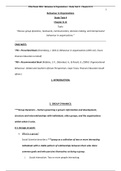©Du Plessis 2016 - Behaviour in Organizations – Study Task 4 – Chapter 8-11
1
Behaviour in Organizations
Study Task 4
Chapter 8-11
Topic:
“Discuss group dynamics, teamwork, communication, decision making, and interpersonal
behaviour in organisations.”
___________________________________________________________________________
TAKE NOTE:
*PB = Prescribed Book (Greenberg, J. (2011). Behaviour in organizations (10th ed.). Essex:
Pearson Education Limited)
*RB = Recommended Book (Robbins, S.P., Odendaal, A., & Roodt, G. (2004). Organisational
Behaviour: Global and Southern African Perspectives. Cape Town, Pearson Education South
Africa.)
1. INTRODUCTION:
2. GROUP DYNAMICS:
***Group Dynamics – Factors governing a group’s information and development,
structure and interrelationships with individuals, other groups, and the organisations
within which it exits.
2.1. Groups at work:
a. What is a group?
Social Scientist describe a ***group as a collection of two or more interacting
individuals with a stable pattern of relationships between them who share
common goals and who perceive themselves as being a group.
i. Social interaction: Two or more people interacting.
, ©Du Plessis 2016 - Behaviour in Organizations – Study Task 4 – Chapter 8-11
2
ii. Stability: Stable structure in groups.
iii. Common interests or goals: Share common interests or goals.
iv. Recognition as being a group: Perceive themselves as a group.
b. What types of groups exist?
i. ***Formal Groups – Groups that are created by organisation, intentionality
designed to direct its members toward some organisational goal.
• Command group – A group created by connections between
individuals who are a formal part of the organisation (i.e., those who
legitimately can give orders to others.)
• Task group – A formal organisational group formed around some
specific task.
• Standing committee – Committees that are permanent, existing over
time.
• Ad hoc committees – A temporary committee formed for a special
purpose.
• Task force: See ad hoc committees
ii. ***Informal groups – Groups that develop naturally among people without
any direction from the organisation within which they operate.
• Interest groups – A group of employees who come together to satisfy
a common interest.
• Friendship groups – Informal groups that develop because their
members are friends, often seeing each other outside of the
organisation.
, ©Du Plessis 2016 - Behaviour in Organizations – Study Task 4 – Chapter 8-11
3
c. Why do people join groups:
People join groups to satisfy their mutual interests and goals. Not only for this, but
they also frequently form groups for purposes of protection from other groups.
Protection and purpose are not the only reasons people form groups, but for social
purposes as well.
2.2. The formation of groups:
Groups don’t simple emerge, they form in a systematic fashion as observed by scientists.
Two particular conceptualizations are as follow:
a. The Five-Stage Mode of Group Formation:
This model identifies 5 distinct stages groups are formed
i. Forming – During this stage, members get acquainted with each other.
ii. Storming – This stage is characterised by a high degree of conflict within the
group.
iii. Norming – During this stage the group becomes more cohesive, and
members begin to identify more strongly with it.
iv. Performing – During this stage, questions about the group relations and
leadership have been resolved and the group is ready to work.
v. Adjouring – Recognizing that all groups don’t last forever, groups may cease
to exist as they met their goals and are no longer needed.
b. The punctuated equilibrium model:
***Punctuated Equilibrium Model – The conceptualization of group development
claiming that groups generally plan their activities during the first half of their time
together, and the revise and implement their plans in the second half.
, ©Du Plessis 2016 - Behaviour in Organizations – Study Task 4 – Chapter 8-11
4
2.3. The Structural Dynamics of Groups:
***Group Structure – The pattern of interrelationships between the individuals constituting
a group; guidelines of group behaviour that make group functioning orderly and predictable.
a. Roles – The Hats We Wear
A ***Role is the typical behaviours that characterize a person in a context.
• Role incumbent – A person holding a particular role.
• Role expectations – The behaviours expected of someone in a particular role.
• Role ambiguity – Confusion arising from knowing what one is expected to do
as the holder of the role.
• Role differentiation – The tendency for various specialized roles to emerge as
groups develop.
• Task oriented Role – The activities of an individual in a group who, more than
anyone else, helps the group reach its goal.
• Relations-oriented Role – The activities of an individual in a group who is
supportive and nurturing of other group members and who helps the feel
good.
• Self-Oriented Role – The activities of an individual in a group who focuses on
his or her own good, often at the expense of others.
b. Norms – A group’s Unspoken Rules:
***Norms are the generally agreed-upon informal rules that guide group
members’ behaviour.
• Perspective norms – Expectations within groups regarding what it is
supposed to be done.
• Proscriptive norms – Expectations within groups regarding behaviours in
which member are not supposed to engage.





